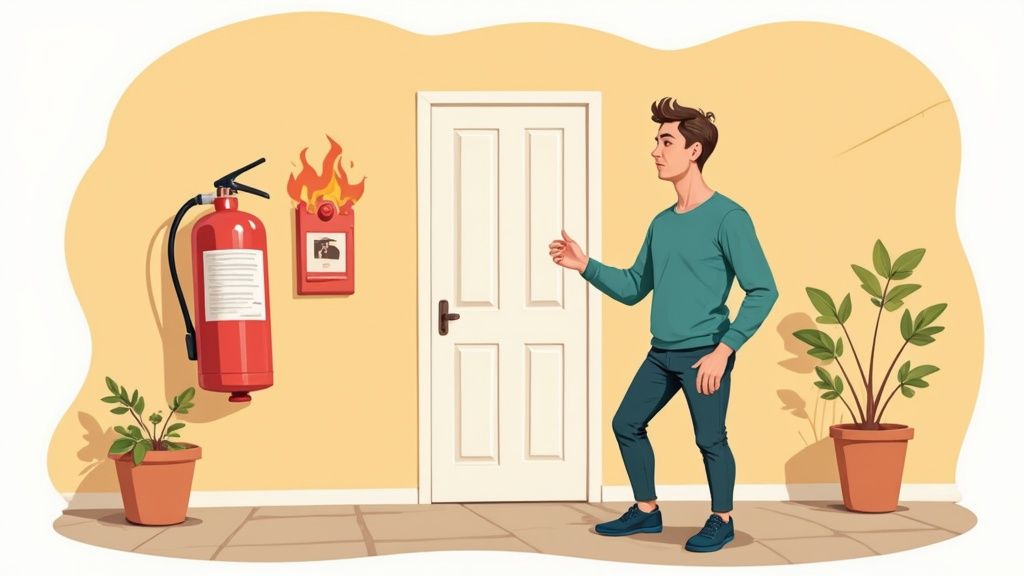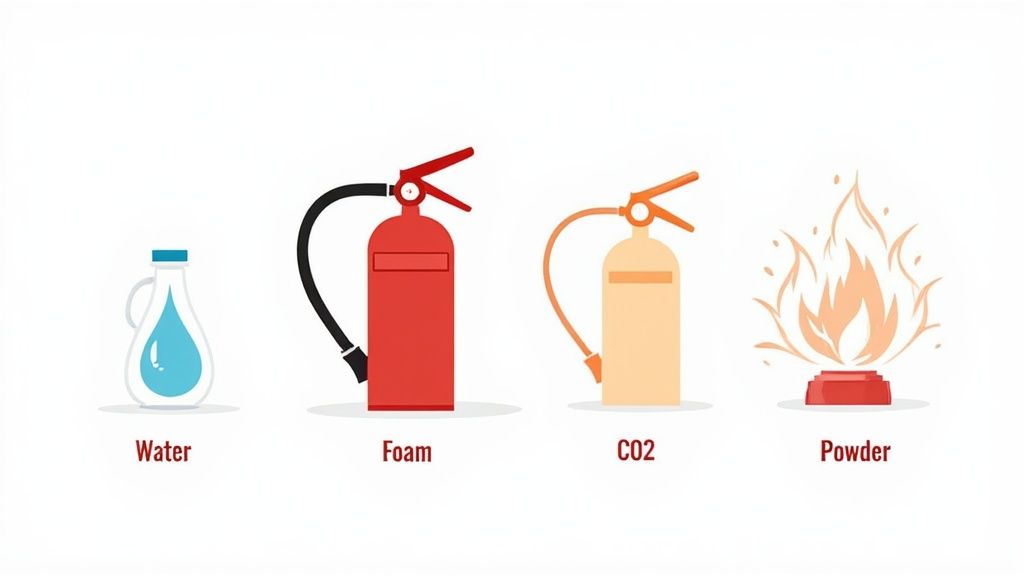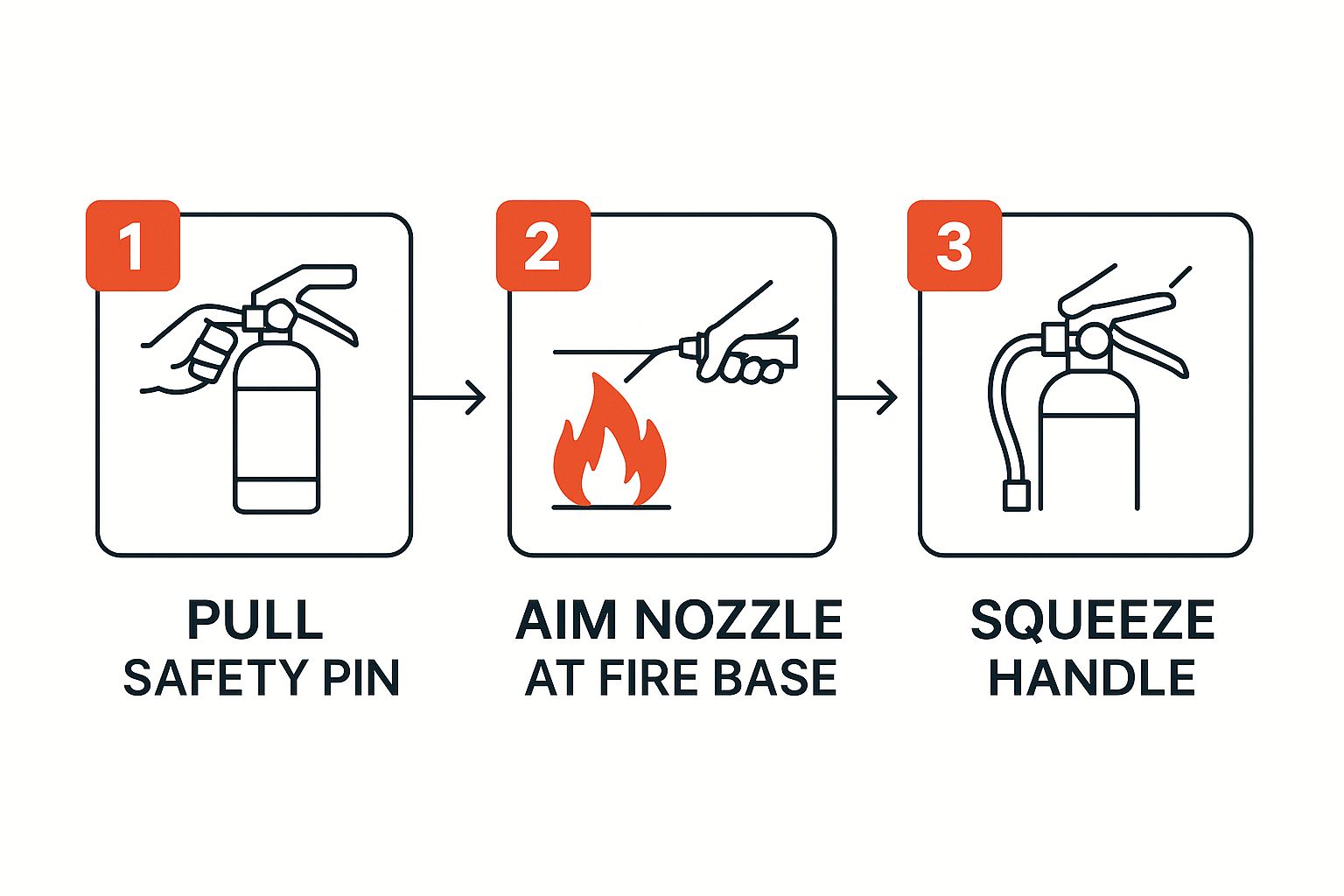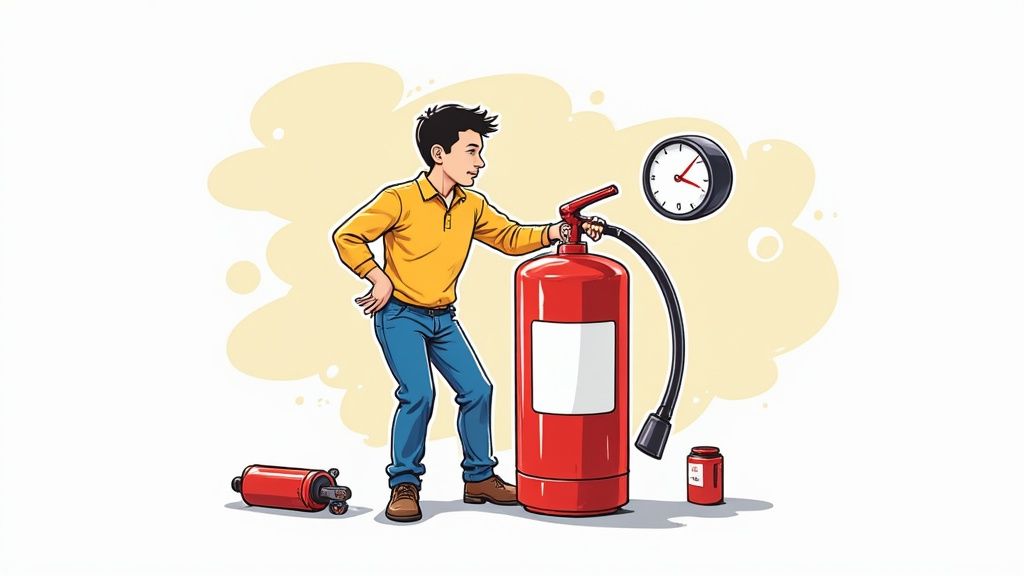When you see a fire, your first instinct might be to grab the nearest extinguisher. But those first few seconds are for a quick, calm assessment. Knowing how to operate a fire extinguisher is critical, but deciding if you should even try is the first and most important step. The decision you make in the first 30 seconds can change everything.
First Actions When You Find a Fire
Before you even think about pulling a pin, your number one job is to make a smart call. A small, contained fire in a bin is one thing. A fire that's already climbing a wall is a different animal and a clear signal to get out, now. Your safety is always the priority.

Your 30-Second Safety Check
Imagine a small fire starts from a piece of faulty equipment on the workshop floor. Before you grab that extinguisher, run through a quick mental checklist.
- Alert Everyone Nearby: Your first move is to shout "Fire!" Make sure everyone in the area knows what's happening. Never assume they've already seen it.
- Confirm Your Escape Route: You must know your way out. Check that the fire is not blocking your exit. If things get worse, you need a clear path to safety.
- Activate the Alarm: If there's a manual fire alarm station nearby, use it. This gets the professionals on their way, no matter what happens next.
- Assess the Fire's Size: Is it small and contained? Or is it spreading fast and creating thick smoke? Only try to fight a fire in its earliest stages.
A fire extinguisher is a first-aid tool for small, manageable fires. If the fire is growing, filling the room with smoke, or blocking your only way out, your job is simple: get out safely.
This quick assessment helps you make that crucial "fight or run" decision. If you have any doubt about your ability to put the fire out or your path to safety, do not be a hero. Get out, close doors behind you to slow the spread, and wait for the emergency services.
Matching the Right Extinguisher to the Fire
Once you decide to fight a fire, you have to grab the right tool for the job. This is not optional. Using the wrong fire extinguisher can be useless at best and dangerous at worst.
For example, spraying water on a grease fire will just spread the burning oil everywhere, turning a small problem into a massive one. This is why knowing how to operate a fire extinguisher starts with correctly identifying the fire before you act.

Fires are classified based on their fuel source. On a construction site or in a manufacturing plant, you're likely to find several different types. Understanding these classes is the key to choosing the correct extinguisher quickly when the pressure is on.
Understanding Fire Classes and Colour Codes
Every fire extinguisher in Australia is colour-coded for a reason: to help you make a split-second decision in an emergency. That band of colour tells you exactly what's inside the canister and what kind of fire it's designed to handle.
Here’s a quick rundown of what you’ll see on site:
- Class A (Ordinary Combustibles): These are fires fuelled by materials like wood, paper, or plastic. A Water extinguisher, which is a solid red cylinder, is used here.
- Class B (Flammable Liquids): This class covers fires involving petrol, oil, or paint. For these, you’ll need a Foam extinguisher (red with a blue band) or a Dry Chemical Powder unit (red with a white band).
- Class E (Electrical): This is any fire involving live electrical gear. Never use water. You need to reach for a Carbon Dioxide (CO2) extinguisher (red with a black band) or a Dry Chemical Powder unit.
- Class F (Cooking Oils and Fats): Common in kitchens, these fires need a special Wet Chemical extinguisher, which has a red cylinder with an oatmeal-coloured band.
Grabbing the wrong extinguisher is a critical and common mistake. Using a water extinguisher on an electrical fire, for example, could lead to electrocution. Always check the label and colour band before you pull that pin.
Quick Reference: Fire Extinguisher Types and Their Uses
To make things even clearer, here’s a straightforward table that matches Australian fire classes to the right extinguisher. Having this memorized can save precious seconds.
| Fire Class | Fuel Source Example | Extinguisher Type | Cylinder Colour |
|---|---|---|---|
| Class A | Wood, paper, textiles | Water, Foam, Powder | Solid Red, Red/Blue, Red/White |
| Class B | Petrol, diesel, paint | Foam, Powder, CO2 | Red/Blue, Red/White, Red/Black |
| Class E | Live electrical gear | Powder, CO2 | Red/White, Red/Black |
| Class F | Cooking oils, fats | Wet Chemical | Red/Oatmeal |
This simple chart is one of the most important pieces of safety information you can learn. Knowing it well means you can react correctly without hesitation.
A Practical Guide to the PASS Method
When you're faced with a small, manageable fire, knowing how to use an extinguisher properly is key. The technique taught by fire professionals is the PASS method. It’s an easy-to-remember acronym and a proven sequence that gives you the best chance of putting out a fire quickly and safely.
Australian fire safety guidelines are built around the P.A.S.S. technique. Studies show that people who follow these four simple steps correctly have a much higher success rate, which can stop a minor incident from becoming a major disaster.
Here’s a quick visual breakdown of what you need to do.

This image shows the three most important physical actions you need to take to get that extinguisher working when seconds count.
Pull the Pin
First things first: Pull the pin. You’ll find it at the top of the extinguisher's handle. Its job is to prevent someone from accidentally discharging it.
The pin is usually secured by a plastic tamper seal. You'll need to break that seal with a sharp, firm tug. Don't be gentle; it’s designed to be broken in an emergency. Just pull it straight out.
Aim Low
This is where most people get it wrong. You have to Aim the nozzle at the base of the fire, not the flames themselves. Spraying into the middle of the fire is ineffective. The fire is feeding on fuel at its source, and that’s what you need to cut off.
Aiming at the base of the fire starves it of fuel. Point the nozzle directly at whatever is burning on the ground or surface.
Squeeze the Handle
With the nozzle aimed correctly, Squeeze the handle or lever. Do it smoothly and evenly to release the agent inside.
Keep a steady pressure on the handle for a constant discharge. If you let go, the flow will stop. Don’t release it until the fire looks like it’s completely out. Following clear, simple steps like this is a key part of all good safe work procedures.
Sweep from Side to Side
Finally, Sweep the nozzle from side to side across the base of the fire. Imagine you’re using a broom to sweep the floor. That’s the kind of steady, deliberate motion you want. This covers the fuel source and smothers the fire.
Continue sweeping until the last flame is gone. Even then, don’t turn your back. Keep a close eye on the area for a few moments to make sure it doesn't flare up or re-ignite.
Actions to Take After Using an Extinguisher
So, you’ve successfully put out a fire. Good job. But your responsibilities don't stop just because the flames are gone. What you do next is just as important for keeping everyone safe and making sure you're ready for the next emergency.

First, back away from the scene slowly. Keep your eyes locked on the area where the fire was. You're looking for any signs of re-ignition like smouldering embers or small flare-ups. Hotspots can easily catch again, so don't turn your back until you're at a safe distance and confident the danger has passed.
Once you’re clear, you must report the incident to your supervisor or the designated safety officer. This is not optional, no matter how small the fire seemed. Every fire needs to be officially documented.
Secure and Replace the Equipment
Now, let's talk about that extinguisher you just used. This is probably the most critical post-fire task you'll handle. Fire extinguishers are one-use devices. The moment you break that seal and discharge it, even for a split second, it can't be trusted again.
Leaving a partially used extinguisher on the wall is a massive safety hazard. It creates a false sense of security, and it might not have enough pressure to work a second time. That's a risk you can't afford.
After any use, that extinguisher must be taken out of service immediately. It's a simple process:
- Lay it Down: Place the used extinguisher on its side on the floor. This is the universal sign that the unit is empty. It’s a clear visual cue for everyone.
- Report It for Service: Let your safety team know the extinguisher needs to be recharged or replaced. Most are rechargeable and require a professional service, while disposable ones need to be swapped for a new unit.
Don't put this off. Getting a fully charged, working extinguisher back in its designated spot as quickly as possible is a fundamental part of keeping your worksite safe.
Keeping Your Fire Extinguisher Ready for Action
Knowing how to use a fire extinguisher is critical, but that knowledge is useless if the extinguisher itself doesn't work when you grab it. That’s why a quick, regular visual check is one of the most practical things anyone on site can do.
It takes less than a minute.
This simple habit gives you confidence that the equipment will actually function in an emergency. It's a small task that makes a huge difference.
What to Look For in a Visual Check
A quick look can spot a major problem long before it becomes a disaster. Here's what to check.
- Check the Pressure Gauge: Find the needle. It needs to be in the green zone. If it’s not, the extinguisher isn’t properly pressurised and won't work correctly.
- Inspect the Pin and Seal: Make sure the locking pin is still in place and the plastic tamper seal is unbroken. If that seal is snapped or the pin is gone, you have to assume the unit has been used or tampered with.
- Look for Obvious Damage: Give the cylinder a quick scan for any clear signs of trouble like rust, dents, or leaks. You should also check that the nozzle is clear of dirt, dust, or anything else that could block it.
An extinguisher with a broken seal or a pressure gauge outside the green is not a reliable tool. Report it to your safety supervisor immediately so it can be serviced or replaced.
Finally, take a quick look at the maintenance tag. It will tell you when the extinguisher was last professionally serviced, giving you the full picture of its readiness.
For a more organized approach, keeping a digital log of these checks using a simple health and safety management software can make tracking much easier.
Common Questions About Using a Fire Extinguisher
Even with good training, facing a real fire brings up questions that can make anyone hesitate. Let's run through some of the most common concerns and get you some quick, practical answers.
How Close to the Fire Should I Get?
Start from a safe distance, usually about 2 to 3 metres away. This gives you a buffer from the heat and keeps you out of the immediate danger zone.
As you get the fire under control and it starts to shrink, you can then move in a bit closer. The key is to make sure you've properly extinguished it at the base. Most importantly, always position yourself with a clear exit behind you. If things go wrong, you need an escape route you don't have to think about.
What if the Fire Extinguisher Does Not Work?
If that extinguisher won't discharge or isn't having any effect on the flames, your next move is simple: get out. Don't waste precious seconds trying to fix it or hoping it will start working.
Your safety is the absolute priority. Evacuate the area immediately, and if you can, close the door behind you to help contain the smoke and slow the fire's spread. Make sure the fire brigade is on the way. These moments, while scary, are also valuable learning opportunities. Sometimes, a failed extinguisher highlights exactly what is a near miss and what could have easily become a tragedy.
Can I Use an Extinguisher Again After a Small Fire?
Absolutely not. The moment you break that seal and use an extinguisher, even for just a second, it’s done. It immediately begins to lose pressure and can't be relied upon for the next emergency. It has to be professionally recharged or replaced right away.
A partially used extinguisher is effectively an empty one in the next emergency. Leaving it in place creates a false and dangerous sense of security.
At Safety Space, we understand that managing safety equipment and procedures is a full-time job. Our all-in-one platform helps you track inspections, document incidents, and ensure your team is always prepared. Simplify your compliance and protect your people by booking a free demo at https://safetyspace.co.
Ready to Transform Your Safety Management?
Discover how Safety Space can help you build a safer, more compliant workplace with our comprehensive safety management platform.
Book a Free DemoRelated Topics
Safety Space Features
Explore all the AI-powered features that make Safety Space the complete workplace safety solution.
Articles & Resources
Explore our complete collection of workplace safety articles, tools, and resources.
